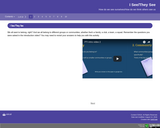
This is an activity for students to create their own I see/they see cartoon similar to what is in the book.
- Subject:
- Arts and Humanities
- Literature
- Material Type:
- Activity/Lab
- Author:
- Lisa Stone
- Date Added:
- 08/24/2018

This is an activity for students to create their own I see/they see cartoon similar to what is in the book.
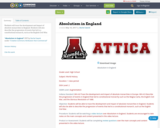
Students will trace the development and impact of absolute monarchies in England. Students will also describe the progression of events that led to a constitutional monarch, such as the English Civil War.
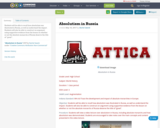
Students will be able to recall how absolutism was illustrated in Russia, as well as understand the impact. Students will also be able to construct on argument using supportive evidence from the lesson on whether or not the absolute monarchs of Russia deserve the title of “great”.

This module introduces the concept of biological absorption, storage and distribution of chemicals.
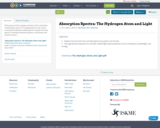
This group activity engages students in the calculation of absorption spectra. It is appropriate for any course covering the baseline mathematical concepts of atomic spectra, including chemistry, physics, astronomy, and related courses.
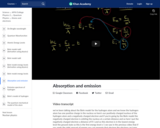
Using shell model diagram to relate absorption to emission. Derives relationship between emitted photon and energy levels, the Balmer-Rydberg equation. Created by Jay.
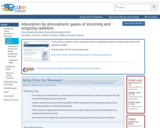
In this activity, students use the absorption spectra of greenhouse gases to explore the nature of the greenhouse effect.
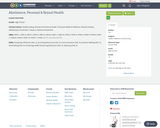
Grade: High SchoolContent Areas: Healthy Eating, Mental & Emotional Health, Personal Health & Wellness, Physical Activity, Safety/Injury Prevention, Tobacco, Violence PreventionHBOs: MEH-1, MEH-2, MEH-3, MEH-4, MEH-5, MEH-6, MEH-7, MEH-8, PHW-2, PHW-3, PHW-4, PHW-5, PHW-6, PHW-7, PHW-8, PHW-9, PHW-10, PHW-11, PHW-12, T-1, T-2, T-3, T-4, T-5Skills: Analyzing Influences (Std. 2), Accessing Resources (Std. 3), Communication (Std. 4), Decision Making (Std. 5), Goal Setting (Std. 6), Practicing Health-Enhancing Behaviors (Std. 7), Advocacy (Std. 8)
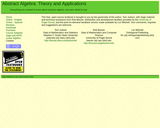
This text is intended for a one- or two-semester undergraduate course in abstract algebra. Traditionally, these courses have covered the theoretical aspects of groups, rings, and fields. However, with the development of computing in the last several decades, applications that involve abstract algebra and discrete mathematics have become increasingly important, and many science, engineering, and computer science students are now electing to minor in mathematics. Though theory still occupies a central role in the subject of abstract algebra and no student should go through such a course without a good notion of what a proof is, the importance of applications such as coding theory and cryptography has grown significantly.
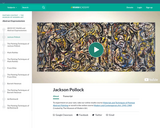
This art history video discussion examines Jackson Pollock's "One: Number 31", 1950, Oil and enamel paint on unprimed canvas, 1950 (MoMA).

This lesson reviews the six types of nouns and then focuses in on abstract nouns. The students will do a creative writing paragraph with the use of an abstract noun and that emulates Rand's writing style.

Art can be found in everything, even ordinary objects. Artist David Huffman finds that abstraction is a great way to delve into the meaning and symbolism of everyday objects, like a basketball or a shoe. Find your own inspiration and create some abstract art -- it might have more meaning than you might think!
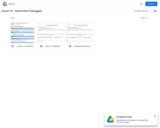
In this lesson, students will be presented with a project that they will decompose with their partners without having access to its code and without access to a computer. Students will work in teams to recreate the project shown in the following lesson.
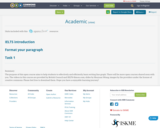
The purpose of this open course aims to help students to effectively and efficiently learn writing line graph. There will be more open courses shared soon with you.
The videos in this course are provided by British Council and IELTS-Simon.com; slides by Shuyuan Wang; images by the providers under the license of creative commons.
Please feel free to download them.
Hope you have a enjoyable learning journey!
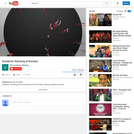
This video explains the concept of academic advising at the UFS.

Being active in social media, like in Twitter and Blogs, is one way to reach a larger audience and to enhance a researcher’s impact. Other researchers will learn about their findings through these additional channels and in addition the public, policy makers, and the press. The toolkit shows several ways of how to get in touch with other researchers and discuss findings at an early stage in research networks, conferences, and in social media. It presents open tools for co-writing, online meetings, reference- and project management.
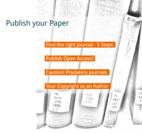
The aim of this toolkit is to support early career researchers in finding a journal that publishes their paper and optimally promotes the visibility of their research. How can they find a journal with a good journal ranking score that is perceived in the respective research community? How can they find a journal that perfectly matches their topic? Should they consider publishing open access? What are predatory journals and how can they detect them?

This worksheet prompts students to consider their digital identity in terms of academic development and to prepare for a portfolio project. Created by Steven Harris-Scott, Ph.D., and Amy Lewis, Ed.D., for INTO George Mason University with support from Mason 4-VA. Attribution-NonCommercial 4.0 International (CC BY-NC 4.0)
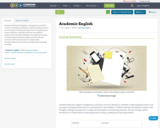
Academic/Business English is designed as a practical course to develop an authentic understanding of how to use concepts of writing and discourse to communicate in the workforce. Students will have the ability to express their thoughts, feelings, and opinions in using real-life situations and learning scenarios. All new concepts will be introduced in context while incorporating various writing, speaking and listening activities.
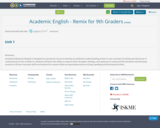
Academic/Business English is designed as a practical course to develop an authentic understanding of how to use concepts of writing and discourse to communicate in the workforce. Students will have the ability to express their thoughts, feelings, and opinions in using real-life situations and learning scenarios. All new concepts will be introduced in context while incorporating various writing, speaking and listening activities.